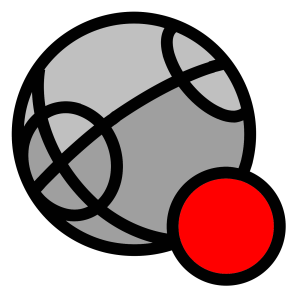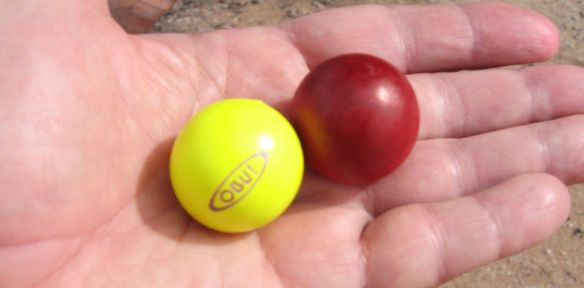pétanque — feet planted (firmly on the ground)

Q: What is the origin of the word “pétanque” (French) or “petanca” (Spanish)?
A: Two Occitan words meaning “feet” and “planted” were transliterated into French and then collapsed into the single French word “pétanque”.
Occitan (pronounced oksitan) is the old pre-French language of Provençe. Like French, Italian, and Spanish, Occitan is a “romance language” — a language descended from the language of the ancient Romans who occupied southern France and Spain for many centuries. Provençal is one of the six major dialects of Occitan. Occitan’s closest relative is Catalan, the language of Catalonia, the north-eastern Spanish province.
Occitan is not French, but the two languages are related through their Roman ancestry. In some cases, an Occitan word will resemble its French counterpart, and (thanks to the Norman Conquest) sometimes resemble a related English word. The Occitan word pèd (foot), for example, is related to the French word pied (foot) and such English words as “pedal”, “pedestrian”, and “podiatrist”.
As I say, we know that two Occitan words were run together to create the word pétanque. The first word was pès or pés which meant “feet”. The second word was something like tanca, tanco, tancats, tanqués. Some sources say that this word meant “together” or “tied together” while others say that it meant “planted”, “fixed”, or “anchored”. A definitive answer can be found in a Petanque America blog entry by Philippe Boets. Here is my lightly edited copy of that post.
Feet fixed or together?
The May, 2009 issue of France Today magazine lists a number of typical Provence terms, and of course “pétanque” is one of them. I’m so glad they use the term “feet fixed”, as opposed to “feet together”. Too many people think that your feet have to be glued together when you throw.
“tanca” is an old Provençal term meaning “blocked” or “fixed”. In todays’ Catalan, closely related to Provençal, the verb “tancar” is still used in that sense, and more generally as a term for “to close”. Because when you “block” an entrance or “fix” a window, you prevent further use, and actually “close” it.
It evolved into French as “tanquer” (“-er” being the common ending for a verb), also as a reflexive verb “se tanquer” meaning “to get stuck”, hence “to be stuck”.
The idea of standing still (or “being stuck”) when throwing a boule was quite revolutionary in 1907. For centuries folks had been running, jumping, you name it, when throwing boules. Imagine telling a javelin thrower today that there’s no more run-up.
A lot of people still think that “tanca” means “together”. No one cares how close together your feet are, as long as they’re immobile, and — when it comes to formal competitions — fit in the regulation 50cm (20″) diameter circle.
By the way, in the South of France, “tanqué” (the past participle of “tanquer”) is also used to describe someone who is well built, as a compliment: “C’est une femme bien tanquée!”
So the bottom line is that the ultimate origin of the word “petanque” is the Occitan words “pés tanca” which mean, basically, “feet planted (firmly on the ground)”.

 In English we’d say that the boule is kissing the jack. What would a French petanque player say?
In English we’d say that the boule is kissing the jack. What would a French petanque player say?


 Hence also the name of one of the designs in Obut’s old Tatou line of leisure boules— the “Card Carreau”.
Hence also the name of one of the designs in Obut’s old Tatou line of leisure boules— the “Card Carreau”.



